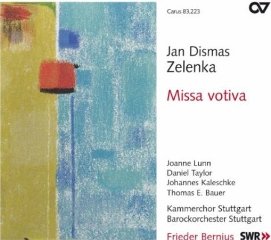Zelenka – Missa Votiva (Bernius) [2010]
Zelenka – Missa Votiva (Bernius) [2010]

1 Kyrie I play 2 Christe Eleison 3 Kyrie II 4 Kyrie III 5 Gloria In Excelsis Deo 6 Gratias Agimus 7 Qui Tollis 8 Qui Sedes Ad Dexteram Patris 9 Quoniam Tu Solus Sanctus 10 Cum Sancto Spiritu I 11 Cum Sancto Spiritu II 12 Credo In Unum Deum 13 Et Incarnatus Est 14 Crucifixus play 15 Et Resurexit 16 Sanctus 17 Benedictus 18 Osanna 19 Agnus Dei 20 Dona Nobis Pacem Joanne Lunn (Soprano), Daniel Taylor (Countertenor), Johannes Kaleschke (Tenor), Thomas E. Bauer (Baritone) Stuttgart Chamber Choir, Stuttgart Baroque Orchestra Frieder Bernius – conductor
Extraordinarily well-written, prodigiously inventive, and relentlessly exciting--these aren't terms normally used to describe 18th-century Masses, but then there is nothing "normal" about this late work by Czech composer Jan Dismas Zelenka. Simply put, if you aren't acquainted with Zelenka (or if you've experienced a previous aversion to Masses), when you hear this piece--a substantial and powerful conception, from the first note of the Kyrie to the final chord of the Dona nobis pacem--you will wonder why this composer does not enjoy much greater esteem and popularity with performers, particularly alongside J.S. Bach (his contemporary) and Mozart.
There certainly is nothing "second-rate" in this music; rather, we hear a composer completely in command and confident in his often unconventional turns of harmony, his compelling, inevitable rhythmic sense, and perhaps most of all, his superhuman (certainly divinely inspired!) affinity for fugal writing. The fugues alone--at least a half-dozen major ones plus several other fugue-like passages--are so finely wrought from a technical standpoint and absolutely infectious in an emotional sense as to cause even the least attentive listener to scramble for the CD player's repeat button. I confess to at least a dozen hearings and I'm still ready for more.
Interestingly--and this you will notice immediately--although Zelenka was older than Bach (he was working in Dresden while Bach was in Leipzig) and died 11 years before Mozart was born, his "theatrical" style (including his dramatic use of the orchestra--the stunning "Et resurrexit", for example), crisply delineated textures, and free-spirited fugues are surprisingly closer to Mozart, bearing almost no resemblance to Bach. And his facile, song-like melodies have more in common with later classical style than with contemporary baroque practice. In fact, the Qui tollis could be a lost movement from Mozart's Requiem; and where/how do you classify the scintillating syncopated fugue in Cum Sancto Spiritu II? Perhaps most impressive is how Zelenka even creates a Credo of such salience and substance that you want to hear it again and again!
Of course, credit must go to the Stuttgart forces and conductor Frieder Bernius for enlivening this music not just with a faithful rendition of notes but with exemplary choral singing and orchestral ensemble playing characterized by vivid color, rare precision, and vibrant sonority. The culmination of these virtues can be heard in the alto-solo movement Et incarnatus est or in the choral Crucifixus, in the gorgeous Agnus Dei (a cascade of beautiful harmony), and unusually rousing(!) Dona nobis pacem--but you really can start anywhere and hear ravishing sound and music, one felicitous rhythm, sizzling harmony, and captivating melody after another. And one more thing: the solo singing is uniformly fabulous. No question: This recording has "best choral disc of 2010" written all over it. Don't miss.---David Vernier, ClassicsToday.com
download: uploaded yandex 4shared mediafire solidfiles mega zalivalka filecloudio anonfiles oboom
Last Updated (Wednesday, 09 July 2014 13:31)








